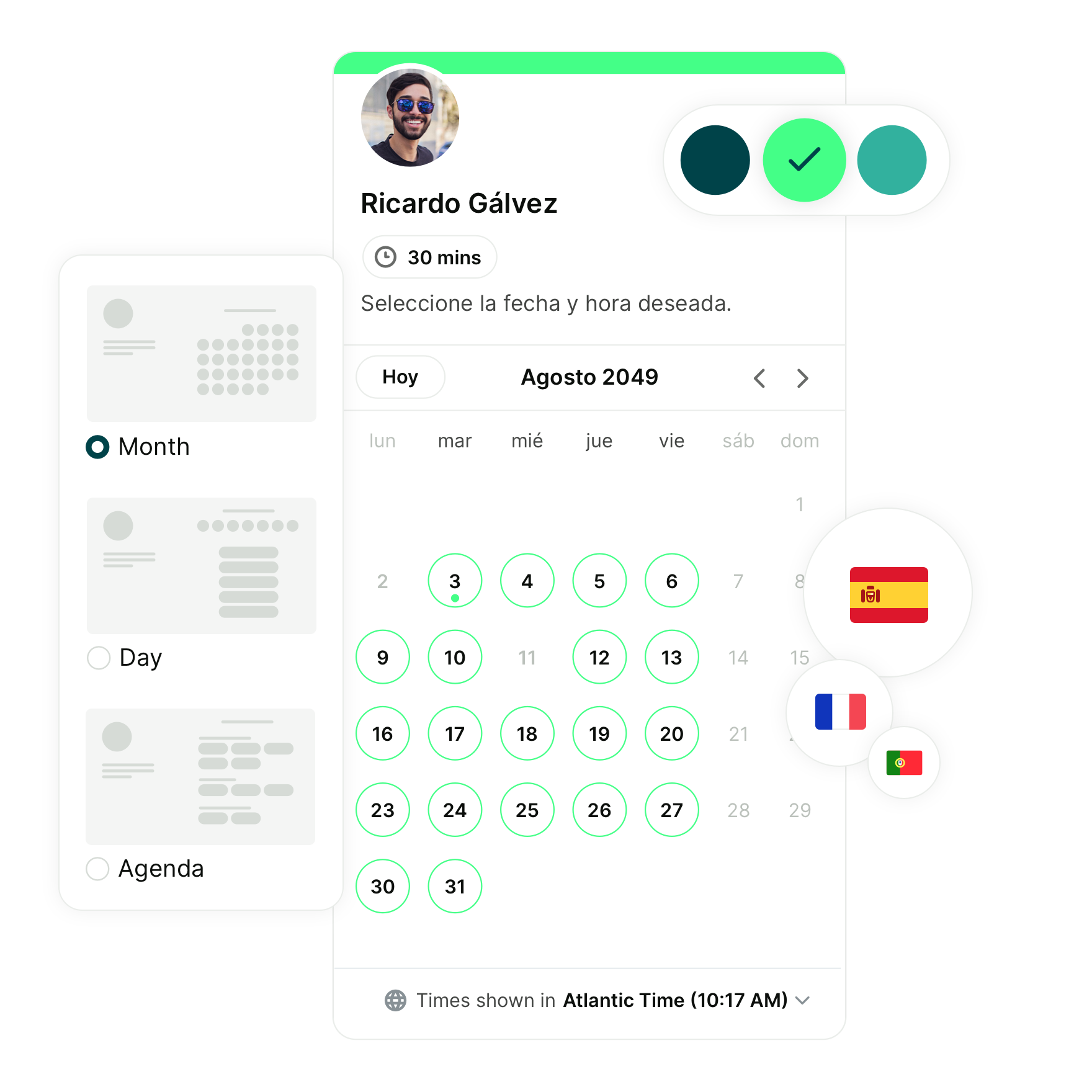How to Share Your Apple Calendar: A Step-by-Step Guide for 2026
Ready to master your schedule? Learn how to easily share Apple Calendar with your clients, friends, and family and streamline your bookings like a pro.

Hannah Ouijdani

Ready to book more meetings?

In this article:
As a small business owner, your calendar is more than just a tool—it's your lifeline. Keeping everyone on the same page can be tricky, but sharing your Apple Calendar makes it easier than ever.
In this step-by-step guide, we’ll show you that there’s nothing easier than sharing your Apple Calendar—whether you're syncing it with Google or Outlook, sharing it with non-Apple users, or integrating it with YouCanBookMe to streamline all your scheduling needs.
Let’s make your calendar work as hard as you do! 💪
What you’ll need to get started
Before we jump into things, let’s make sure you’ve got everything you need. Sharing your Apple Calendar only works if it’s synced with iCloud, so double-check these steps:
- An iCloud Account: Your calendar needs to live in the iCloud universe for sharing to work.
- Access to an iPhone, iPad, or Mac: You can share from any Apple device, or through iCloud on your browser.
Already set up? Jump ahead!
Setting up and customizing your Apple Calendar
Apple Calendar makes it super flexible to manage not only the visibility of your calendar but also how it behaves. Here’s how to navigate through all the key settings to make your calendar work best for you.
Integrating multiple accounts
You can integrate multiple calendar accounts into your Apple Calendar, such as iCloud, Google, Microsoft Exchange, or Yahoo. Here's how you set them up:
1. Go to Settings > Apps > Calendar.
2. Tap Calendar Accounts > Add Account.

3. Do any of the following:
- Select a service like iCloud, Google, or Microsoft Exchange and sign in.
- Tap Other, then select Add CalDAV Account or Add Subscribed Calendar and enter your account details.

Setting your default calendar
Do you manage multiple calendars but want a specific one to handle most of your new events? You can set a default calendar so that any new events automatically go there.
1. Go to Settings > Apps > Calendar.

2. Tap Default Calendar and select the one you want to use for new events.

(Note: You can always move an event to a different calendar after creating it, so don’t worry about being locked in.)
Adjusting default event settings
Make your calendar more intuitive by adjusting the default settings for events. This includes alert times, event duration, and even location suggestions:
- Go to Settings > Apps > Calendar.
- Adjust the following:
- Default Alert Times: Choose when to be reminded for birthdays, events, or all-day events.
- Time to Leave Alerts: Turn on "Time to Leave" notifications to get alerts when it’s time to head out for an upcoming event.
- Default Event Duration: Set how long new events last by default (e.g., 30 minutes, 1 hour).
- Location Suggestions: Turn this on or off to get suggested locations for your events.

|
🔑 Pro Tip: For business meetings, you can use location suggestions to quickly input client addresses or meeting spots, saving you the trouble of typing it all out! |
Display settings
Want to change how your calendar looks? You can tweak the display to fit your style and needs. Here’s how:
- Go to Settings > Apps > Calendar.
- Customize any of the following:
- Alternate Calendars: Display an additional calendar (Chinese, Hebrew, or Islamic) alongside the Gregorian one.
- Week Numbers: Show the week number next to each week for easier planning.
- Week View Starts On Today: Set the current day as the first day in your Week View
- Start Week On: Choose the day your week begins (Monday, Sunday, or any other day that works for you!).
How to share Apple calendar
Sharing your Apple Calendar can be super convenient, whether you're planning a family event or scheduling meetings with your team. Let's break down how to share your Apple Calendar on multiple devices.
Sharing from your iPhone or iPad

(Source)
- Open Calendar: Tap the Calendar app and choose the calendar you want to share.
- Tap the Info Button: Hit the “i” next to your calendar.
- Add a Person: Scroll to Add Person, enter their email, and you’re done!
- Set Permissions: Choose whether they can just View Only or View and Edit your calendar.
- Send the Invite: They’ll get an invitation, and once they accept, boom—you’re synced!
Sharing your calendar on Mac

(Source)
If you're using your Mac to manage your iCloud calendars, here's how to share it with others:
- Open the Calendar app on your Mac.
- Place your pointer over the calendar you want to share in the calendar list.
- Click the Share Calendar button.
- Enter the names or email addresses of the people you want to invite.
- You can also invite a group from your Contacts list.
- To allow specific people to view but not edit, choose View Only.
- If you want to make your calendar public (viewable by anyone with the link), select Public Calendar.
- Click Done.
|
🔑 Pro Tip: If someone doesn’t need to edit your calendar, use the View Only setting to keep things simple and prevent accidental changes. |
Once you've shared the calendar, the people you’ve invited will receive an email or notification to join the shared calendar.
Sharing your calendar on iCloud.com
Want to share your calendar straight from your web browser? Here's how to share via iCloud.com:
- Log in to iCloud.com on your tablet or computer.
- Click on the Calendar app.
- Hover over the calendar you want to share and click the Calendar Information button.
- In the Sharing With section, click the Add button.
- Type the email addresses of the people you want to invite.
- Choose the access privileges for each person (Allow Editing or Read-Only).
- Click Done, and an invitation will be sent to your invitees.
This method works great if you’re not at your Mac but still want to manage your shared calendar quickly.
Public vs. private calendar sharing
With Apple Calendar, you can share either privately (only with specific people) or publicly. If you want anyone to access your calendar, without requiring them to have an iCloud account, you can make your calendar public.
 (Source)
(Source)
Private calendar
This is your personal safe space—only you can see and edit it. Keep those confidential client meetings, lunch breaks, or your "me-time" in here. No one else can peek! 😉Public calendar
Want to share your calendar with the world? By making your calendar public, anyone with the link can view it, but they won’t be able to make changes. This is great for things like sharing event dates or schedules with clients or team members without giving them editing access.Invitees
- Invitees: Share your calendar with specific people and set up different permission levels. You can control who can see your events and who can edit them—whether it’s just for viewing purposes or allowing someone else to manage your schedule.
- View-Only: People can see your events but can’t change or delete anything. Perfect for keeping your assistant or colleagues in the loop without risking accidental edits.
- View and Edit: This setting lets invitees add, edit, and delete events. This is handy if you’re managing a collaborative calendar with a team member.
Share your calendar with non-Apple calendar users
Got clients or team members who aren’t in the Apple ecosystem? No problem! You can still share your Apple Calendar with them—and YouCanBookMe makes it even easier.
By making your calendar public, you can generate a shareable link that anyone can view, regardless of whether they use Apple Calendar, Google Calendar, or Outlook. But if you want to keep your schedule private while allowing clients to book time with you, YouCanBookMe is the perfect solution.
|
🤔 Considering Google Calendar? If you're reading this article and thinking, "hmm... Maybe iCal isn't for me?", then check out our comparison of Apple Calendar vs. Google Calendar. |
Here’s why it’s a game-changer for small business owners:
- Multiple Calendar Sync: You can connect Apple Calendar, Google Calendar, and even Outlook all in one place.
- Private Scheduling: Keep your personal and business events private while letting clients book appointments during your free time.
- Real-Time Availability: YouCanBookMe syncs with all your calendars, automatically blocking out unavailable slots—no more double bookings!
Ready to level up your scheduling game? Try YouCanBookMe and connect all your calendars seamlessly!
FAQ
How do I sync Apple iCal with Google calendar?
To sync Google calendar with Apple Calendar, go to iCloud settings on your device, enable syncing with Google Calendar, and you’re good to go. Now you can view both calendars in one place!
Why can’t I share my iPhone Calendar with someone?
Make sure your calendar is stored in iCloud. Only iCloud calendars can be shared—double-check your settings to ensure everything is synced.
How do I give someone access to my Apple Calendar?
Invite them directly through the Calendar app. They’ll get an email, and once they accept, they can view or edit the calendar based on the permissions you set.
Subscribe to our newsletter
Get productivity tips, news, articles and resources.
Written by
Hannah Ouijdani
Hannah never planned to be a content writer, but it’s her favorite happy accident. What started as a passion for all things celestial turned into a popular astrology Twitter account, and soon she was ghostwriting horoscopes, newsletters, and articles for magazines, brands, and even musicians. She’s been Head of Copy at a creative agency, where her love for space and science fiction naturally pulled her into the worlds of SaaS, AI, and the coolest tech. Now, she dreams of being the first writer to advertise on Mars.

